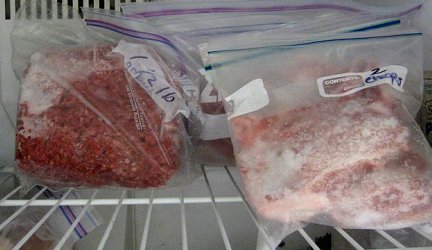Where’s the Beef? Get yours Organized
“Where’s the beef,” the cranky senior citizen would whine in the decades old Wendy’s ad.
It is sure hoped that the answer to that question, now a popular pop culture catch phrase, does not lie anywhere near your fresh produce. The beef, and your other meats, have their very own organizing issues.
Since organizing has to do with how and where we store things, then organizing meat is indeed a great kitchen topic. Saving money in the kitchen is important in nearly every household and meat is near the top of cost at the store. Buying and handling meat on sale and making good use of it is more important than ever.
Organizing Meat in the Refrigerator:
Organize the fridge and freezer because It is really important to avoid cross-contamination of bacteria in your refrigerator. A wet package of chicken may quickly drip into a bowl of salad or onto apples.
Take the time to always store meat in the lowest level of your refrigerator. Do not place the package, which may have bacteria on the wrappings, directly on the shelf. Place your meat package on a rimmed baking sheet, a plate or in a plastic container. This will keep your shelves clean and contain any dripping juices so that they do not run into other foods in the fridge. Most raw meat can be kept in the refrigerator for one to two days but if you are not going to cook it in that time period, you should move it to the freezer.
If you are a busy cook, you might find dinner preparation easier if you take a bit of time with the meat before freezing. Pounding chicken breasts, trimming fat, cutting cubes for stew or even browning batches of ground beef can make dinner a snap on hectic nights.
Organizing Meat in the Freezer:
 Both cooked and raw meat can be frozen.
Both cooked and raw meat can be frozen.
Make sure that the meat is well marked with a name and a date.
Should you find you have thawed too much meat for a given meal, do not place it back in the freezer. Go ahead and cook the meat, then freeze the extra cooked meat to be used in a casserole or other dish on another day.
For best results in freezing meat, you will need to add additional wrappings to your store-bought meat. The store plastic wrap is not thick enough to protect the meat quality for a long period. You can drop your meat into freezer zippered plastic bags, wrap them in freezer paper or foil.
Wrapping chicken breasts, steaks or chops individually will allow you to remove only the number you need for a given dinner. If you do choose to freeze the whole package, plan on using the whole package as they will have stuck together upon freezing.
Avoid cross contamination of meat in your freezer as well. Organize your freezer into areas. Store the meat in one area so that if there are any bacteria on the outside of a package, you will not get it in every area of the freezer. Wiping packages off with soapy water before storing in the freezer doesn’t hurt either.
Create an inventory list for your freezer on a wipe-off board. This will help you know what is at hand without digging through packages. It will also help eliminate waste because you will use meat before it gets freezer-burned.
Make it a habit to add new purchases to the back of the shelf, pulling older meat packages forward so you can use them first.
Add wire baskets or plastic baskets to your chest or upright freezer. You can use these to sort your meat from other packages. You can also sort chicken, beef and pork into baskets, making it easier to find.
Because freezer shelves are almost always wire grids, you can add labels by tying them to the racks or to the baskets. Plastic luggage tags can be wiped off and are good for this purpose.
When you have thawed meat for cooking, it should not feel slimy nor should it have an offensive odor. If it does, discard it.
Things to Know:
Cross contamination can occur after cooking. Make sure to throw away the meat wrapper and clean countertops with soapy water or disinfectant before setting dishes or other foods on the counter. Always grab a clean plate or dish for the cooked meat.
Use two cutting boards, designating one for meat and the other for produce.
While you are stocking up on organizing products for this project, toss a refrigerator/freezer thermometer in your cart. Freezers should be at 0 degrees F or below and fridges at 34-40 degrees F, according to Clemson Extension Service.
Save money on meat by buying family-size packages or meat on sale and dividing them into smaller portions. You can take a sharp knife or kitchen sheers and cut through the large Styrofoam tray, meat and plastic, thus dividing the large package into sections. Drop each in a freezer bag. Label and freeze.
 Author Lea Schneider, a columnist for What’s Cooking America, is a freelance writer and organizational expert whose organizing ideas have been published in many magazines including Woman’s Day, Better Homes and Gardens Kitchen and Bath Ideas, Family Circle, Parents Magazine, as well as numerous newspapers and websites. She is a member of the Association of Food Journalists.
Author Lea Schneider, a columnist for What’s Cooking America, is a freelance writer and organizational expert whose organizing ideas have been published in many magazines including Woman’s Day, Better Homes and Gardens Kitchen and Bath Ideas, Family Circle, Parents Magazine, as well as numerous newspapers and websites. She is a member of the Association of Food Journalists.
Getting organized is all about living simpler and making things easier. The bonus is it often leads to saving money. Lea Schneider’s kitchen organizing columns tell you how to organize the many things that relate to kitchens, menus, meals, and special food events.
Check out all of Lea Schneider’s helpful home and kitchen columns at Organizing Kitchens, Pantries, Menus and Meals.
Categories:
Kitchen Organization